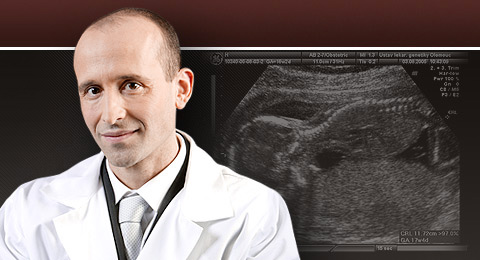Lubusky M., Prochazka M., Langova M., Vomackova K., Cizek L. Discrepancy of ultrasound biometric parameters of the head (HC - head circumference, BPD - biparietal diameter) in breech presented fetuses. Bimed. Pap. Med. Fac. Univ. Palacky Olomouc Czech Repub., 2007, 151 (2), p. 323-326.
Introduction
Ultrasonographic fetal biometry is the most widespread method used to establish gestational age, estimate fetal size and monitor its growth. BPD and HC measurements are performed routinely during the prenatal ultrasound screening in the third trimester of pregnancy.
However, baseline data for these head dimensions are constructed from a sample of the general obstetric population, and therefore include only a minority of fetuses in the breech position in the third trimester. Such a subgroup may have signifi cantly diff erent head dimensions which may not signifi cantly aff ect the distribution of values for the population sample; however, extrapolation from this sample to an individual of such a subgroup could lead to serious error.
The BPD in a normally growing fetus presented in the breech position is frequently much less than what is anticipated based on gestational age. This small BPD is consistent with the description of the “breech head” by Haberkern et al.1 who used the term to denote scaphocephaly, a prominent occiput and an occipital shelf. Scaphocephaly, however, implies premature fusion of the saggittal suture as the cause of an elongated skull which was not demonstrated in any of the eight babies described by Haberkern et al.1. Dolichocephaly seems a
Materials and methods
Ultrasound examinations were performed prospectively at the Department of Obstetrics and Gynecology and at the Department of Medical Genetics and Fetal Medicine at Palacký University Teaching Hospital in Olomouc. All the scans were performed transabdominally using 5-MHz transducers (GE Voluson 730 Expert, GE Healthcare Technologies, Zipf, Austria). Ultrasonographic measurements were performed using standard methodology.
Ultrasound biometry was performed in accordance with the method presented in the reference tables. In all breech-presented fetuses, the HC, BPD, AC (abdominal circumference) and FL were measured. Hadlock normograms3 were used to quantify the biometric parameters. For a clear clinical interpretation, the corresponding gestational age for the individual parameters (HC, BPD, AC and FL) was expressed in days. The biometric parameter used to determine gestational age was femur length, which is not gender-dependent 4–6, and in all our cases it correlated with the fi rst trimester ultrasound biometry (crown-rump length – CRL). Growth retarded fetuses and high-risk or multiple pregnancies were excluded from the study. All the measurements were performed by one examiner.
Statistical analysis was performed using the Mann- Whitney U-test. All values with p<0.01 were considered statistically signifi cant.
Results
A total of 111 ultrasonographic biometries were performed between the 31st–38th> week of gestation. Fetuses in the breech position had a signifi cantly lower BPD compared to HC. HC parameter correlated with gestational age. The diff erence between BPD and HC was 16.2 days (95 % Cl 14.3–18.1; p = 0.001). The distributions of ultrasound examinations at diff erent stages of gestation are shown in Fig. 1. Discrepancies in ultrasonographic biometric head parameters (HC, BPD) of fetuses in the breech position are demonstrated in Figs. 2 and 3. Maternal age at delivery was 20–36 years (average 28.1; median 28.0).
Discussion
Fetuses in the breech position have a signifi cantly smaller BPD compared to fetuses in the head-down position in the third trimester as well as postnatally7–9. This is caused by mild cranial deformation which occurs antepartally in at least one-third of fetuses in the breech position7. Features of this (mild) cranial deformation (dolichocephaly, a prominent occiput with a suboccipital shelf, an elongated face and a parallel-sided head) constitute the "breech head"1, 7. The caliper-determined occipito frontal/ biparietal diameter ratio (OFD/BPD) in these newborn infants is consistently above 1.3 (Figs. 3 and 4). This ratio, when calculated from ultrasound examination in the third trimester, was also found to correlate well with the "breech head" shape. Ultrasound identifi cation of these babies should prevent the misdiagnosis of fetal growth retardation based on serial BPD measurements alone.
The term "breech head" in reference to the cranial deformity was fi rst suggested by Haberker et al.1 and implicates the most common etiology. The distinctive distortion of the cranium is presumably secondary to the forces applied to the growing cranium by the uterine fundus as the fetus is constrained in the breech position in late gestation, often with the head retrofl exed. The term size, primiparity and oligohydramnios were recognized as additional factors predisposing to in utero constraint. In babies with "breech head" screened ultrasonographically by Kasby et al.7, the placental site was usually posterior and it is suggested that this leads to closer apposition of the fetal scull to the uterine fundus, which in turn can exert a compression eff ect. Once the constraint is relieved postnatally, the head shape has the potential for complete resolution. In itself, the deformation does not indicate an underlying calvarial or CNS structural malformation1
It is likely that the altered head shape is a refl ection of intrauterine environmental factors and it suggests that the cranial abnormality under consideration is a postural deformation associated with the in utero breech position. It is not known how early the head deformation can occur, but we have ultrasound evidence of marked dolichocephaly in the breech fetus as early as 31 weeks.
The evidence presented as well as our results show that in a considerable proportion of breech babies the BPD is smaller than expected from the commonly accepted norms without necessarily refl ecting growth retardation. It further acknowledges that gestational age prediction from the third trimester BPD is unreliable.
The OFD/BPD ratio was found to be a valuable index for identifying the "breech head”7. This ratio is a measure of dolichocephaly and a value above 1.30 is consistent with a small BPD in babies without other evidence of intrauterine growth retardation. An OFD/BPD ratio greater than 1.30 determined by ultrasound in the third trimester should caution the sonographer not to assume that the menstrual dates are incorrect or that the fetus is growth retarded. Third trimester ultrasound measurements of head circumference (HC), femur length (FL) and abdominal circumference (AC) should be used in preference to the biparietal diameter (BPD) for the assessment of fetal growth.
Conclusions
According to our results, fetuses in the breech position have a signifi cantly lower BPD in comparison with HC or FL. HC and FL parameters correlate with gestational age. In cases of ultrasonographic biometric discrepancy between BPD and FL, the fetal position should be taken into account. Breech presented fetuses have an elongated head shape and ultrasound biometrics should evaluate its circumference (HC). It is important to responsibly interpret the results so as not to stress the expecting mother with suspicions of fetal pathology. Nonetheless, in cases of "breech head", fetuses should be delivered once full term is reached.
Acknowledgements
This study was supported by the Medical Faculty of Palacký University Olomouc “Safety of Ultrasound in Medicine”.
References
- Haberkern CM, Smith DW, Jones KL. The “breech head” and its relevance. Am J Dis Child 1979; 133:154–6.
- Sunderland R. Fetal position and skull shape. Br J Obstet Gynaecol 1981; 88:246–9.
- Hadlock FP, Deter RL, Harrist RB, Park SK. Estimating fetal age: computer-assisted analysis of multiple fetal growth parameters. Radiology 1984; 152:497–501.
- Bromley B, Frigoletto FD Jr, Harlow BL, Evans JK, Benacerraf BR. Biometric measurements in fetuses of diff erent race and gender. Ultrasound Obstet. Gynecol 1993; 3:395–402.
- Lubusky M, Mickova I, Prochazka M, Dzvincuk P, Mala K, Cizek L. Discrepancy of ultrasound biometric parameters of the head (HC – head circumference, BPD – biparietal diameter) and femur length in relation to sex of the fetus and duration of pregnancy. Ces Gynek 2006; 71:169–72.
- Schwärzler P, Bland JM, Holden D, Campbell S, Ville Y. Sex-specifi c antenatal reference growth charts for uncomplicated singleton pregnancies at 15–40 weeks of gestation. Ultrasound Obstet Gynecol 2004; 23:23–9.
- Kasby CB, Poll V. The breech head and its ultrasound signifi cance. Br J Obstet Gynaecol 1982; 89:106–10.
- Johnsen SL, Wilsgaard T, Rasmussen S, Sollien R, Kiserud T. Longitudinal reference charts for growth of the fetal head, abdomen and femur. Eur J Obstet Gynecol Reprod Biol 2006; 127:172–85.
- Bader B, Graham D, Stinson S. Signifi cance of ultrasound measurements of the head of the breech fetus. J Ultrasound Med 1987; 6:437–39.
Pozn.: Tabulky, grafy a obrázky naleznete v souboru Format PDF ».

Contact
Professor Marek Lubusky, MD, PhD, MHA
THE FETAL MEDICINE CENTRE
Department of Obstetrics and Gynecology
Palacky University Olomouc, Faculty of Medicine and Dentistry
University Hospital Olomouc
Zdravotníků 248/7, 779 00 Olomouc, Czech Republic
Tel: +420 585 852 785
Mobil: +420 606 220 644
E-mail: marek@lubusky.com
Web: www.lubusky.com


